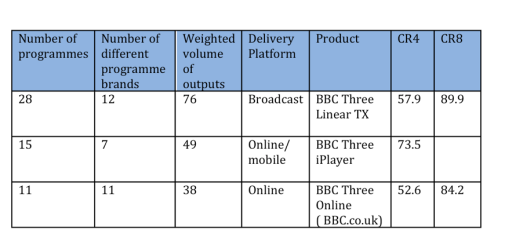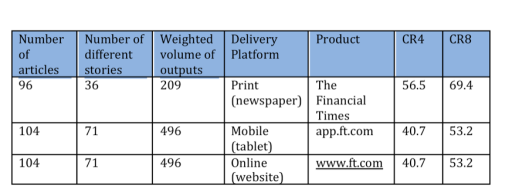By Gillian Doyle
Nowadays more content is accessible, in more formats, on more devices, for more people than ever before. But, as media companies make the journey from being single sector to digital multi-platform suppliers of content, this transition has entailed numerous managerial and economic challenges.
One of the major challenges facing media companies is that they have embarked on multi-platform strategies, which require a greater abundance of content to distribute, at a time when, because of recession or competitive pressures, their budgets have been tightly constrained. How has the transition to a multi-platform environment facilitated such abundance and an apparently miraculous increase in levels of productivity across the media industry?
Strategies of multi-platform expansion are spurred on by recognition or, in some cases, by hope amongst media managers that opportunities exist both to derive new revenues and to improve the management and cost-effective exploitation of media resources. A multi-platform approach means that new ideas for content are considered in the context of a wide range of distribution possibilities (e.g. online, mobile, interactive games and so on) and not just a single delivery platform such as print or linear television. As print publishers become multi-platform publishers, this entails supplying not only just a paper-based product but also digital editions with additional costly features such as embedded video. For broadcasters, becoming a multi-platform supplier entails delivery of content in new guises and formats suited to the array of digital platforms via which audiences may now choose to access such content. The shift to delivery across multiple platforms, including digital platforms which involve two-way connectivity (dialogical interface), has entailed and necessitated a new sort of thinking on the part of media managers and strategists whereby, rather than focusing largely on production and distribution of content, a consideration which now occupies considerable importance is how to build and sustain relationships with audiences.
A central concern in our three-year ESRC-funded research project[i] has been to consider to what extent the widespread adoption of strategies of multi-platform expansion is facilitating opportunities to improve the management and cost-effective exploitation of media resources. However, the concept of cost efficiency is not altogether straightforward when used in the context of media or cultural provision. Whereas in other sectors judgments about efficiency may legitimately be based on what volumes of output can be generated from any given set of resources, efficient use of media resources is not simply about maximising volumes of output but rather it is about supplying output that really meets the needs and wants of audiences and user-groups.
Findings indicate that investment in new equipment and re-training has indeed facilitated improvements in cost efficiency by restraining some of the marginal costs associated with expansion in the supply of media output across multiple platforms. However, evidence from our analyses suggests that practices of extensive recycling and re-use of content by media suppliers which, in many cases, are integral to strategies of multi-platform expansion are also a very major explanatory factor underlying the apparent ‘miracle of loaves and fishes’. Tables 1 and 2 show how for example in an analysis of content for BBC Three and for the Financial Times in Spring 2014, [ii] a predominance across platforms of a relatively small number of content properties –high profile stories or specific programme brands – was evident.
Table 1: BBC Three Content Analysis[1]
[1] Sampling dates 23 and 25 March 2014.
Table 2: Content Analysis of the Financial Times[1]
[1] Analysis based on UK Companies news section. Sampling dates 22-25 April 2014.
Therefore, the apparently miraculous way that media companies have managed, on relatively fixed resources, to multiply the range and volume of their content outputs is explained by the fact that what they are doing, at least some of the time, is recycling the same output across platforms.
While some challenges related to strategic adaptation and organizational renewal are sector-specific – e.g. the quest to counteract loss of classified advertising to online rivals is a particularly acute problem for print publishers – many are shared, such as that faced by most if not all newspapers, television companies and magazine publishers in managing adaptation of production processes and in securing sufficiently high levels of integration between content production and digital specialists to really promote innovation. The experience of leading UK companies suggests that harnessing and exploiting two-way connectivity on digital delivery platforms are seen as pivotal to future growth but, at the same time, associated difficulties – e.g. judging how best to use a ‘tidal wave’ of return path data now potentially available to inform management decision-making – remain considerable.
This article is based on:
Doyle, G (2015), Multi-platform media and the miracle of the loaves and fishes, Journal of Media Business Studies, 12 (1): 49–65.
Author Information:
Gillian Doyle, Director of Centre for Cultural Policy Research (CCPR) at the University of Glasgow.
[i] This blog draws on a project entitled ‘Multi-platform media and the digital challenge: Strategy, Distribution and Policy’ funded by the Economic & Social Research Council (ES/J011606/1).
[ii] For each media proposition (e.g. BBC Three) that we analysed, the eight stories or programme brands with the highest volume on each platform associated with that proposition were identified and the proportion of the volume of the total content accounted for by the top four and the top eight items was calculated as CR4 and CR8 respectively.
Image:
Media Diversity, by Free Press. Creative Commons License.


